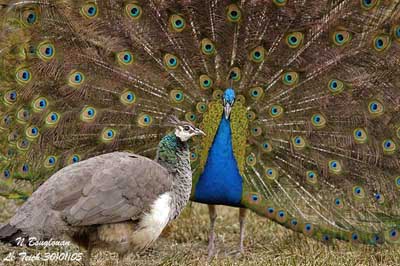
Defence displays by males are important for females, and join the courtship displays, helping them to select the strongest male able to be a good father, a pleasant mate and an efficient protector of the family.
Read more:
Romantic House Sparrow, a new species?
Out of season’s behaviour in Common Kingfisher
Text by Nicole Bouglouan
Photographers:
Didier Buysse
Vision d’Oiseaux
Alfredo Colón
Puerto Rico Wildlife
Jean Michel Fenerole
Photos d’Oiseaux
Steve Garvie
RAINBIRDER Photo galleries
Tom Grey
Tom Grey's Bird Pictures
Patrick Ingremeau
TAMANDUA
Eduardo Andrés Jordan
MIS AVES – AVES DE ARGENTINA
René Lortie
http://rlortie.ca/
Tom Merigan
Tom Merigan’s Photo Galleries
Bob Moul
Nature Photography
Callie de Wet
GALLERY
Nicole Bouglouan
PHOTOGRAPHIC RAMBLE
Sources:
Wikipedia (Wikipedia, The Free Encyclopedia)
Stanford University - Birds of Stanford
SORA Searchable Ornithological Research Archive (Blair O. Wolf)
Birds and Courtship displays
At the end of the winter and through the breeding season, almost all the birds’ species perform displays, either to strengthen the pair-bonds or to create a new one.
These displays are more developed in new pairs because the male needs to attract a female, using for that several types of postures, movements and actions.
In terrestrial displays, different postures are used by males to expose the plumage colours. These displays are performed mainly by birds of the order Galliformes such as pheasants, grouses, partridges and others similar species.
The birds showing very coloured feathers perform elaborated displays to enhance iridescences and glossy areas, bright wing-bars or peculiar head and body patterns. The long tails of several pheasants and peacocks are completely fanned and shaken while the male turns around the female.

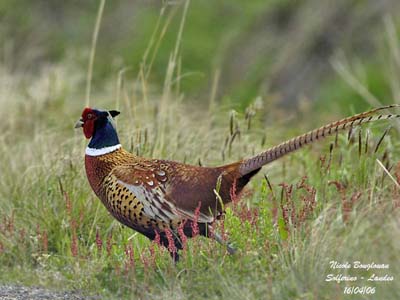
Feathers are ruffled. The bird adopts appropriated postures and performs several movements such as lateral steps, bowing, raising and/or dropping wings and tail, holding the neck and displaying a crest or some bright bare head areas. The head often shows bright coloured wattles playing an important role while the male is strutting.
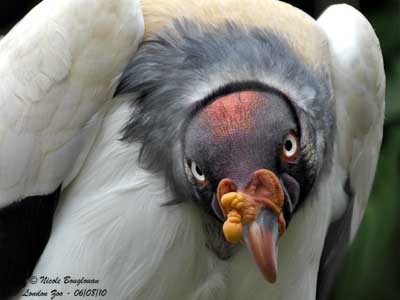
Sarcoramphus papa
The huge beaks of Hornbills, toucans and pelicans also play a role in displays. Often well coloured, some postures enhance this beautiful ornament.
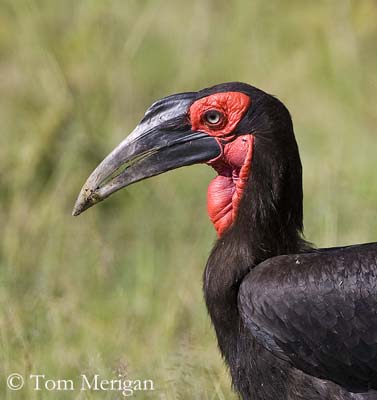
Bucorvus leadbeateri
Displays are often accompanied by sounds. Calls and songs are usually uttered by males, from perch above the territory, but also from bushes or low branches at the boundaries of the area or very close.
Songs are used to attract females, but also as advertising sounds towards rivals. Then, the vocal sounds become softer and are used as communication between both mates.
The small passerines use several calls and songs to attract females, competing with rivals in order to utter the most melodious song or the loudest call to impress a potential mate.
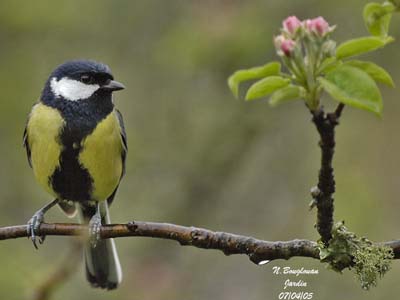
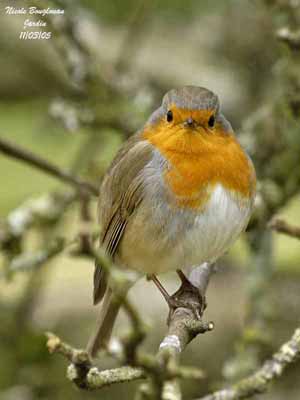
But several species produce non-vocal sounds such as bill-clapping, wing-whirring or wing-flapping, hisses, grunts and others according to the genus. This fact is especially noticed in the Cathartidae vultures.
These actions can occur on the ground, on branches or other places, but usually within the territory, and relatively close to the nest-site, or even at nest.
Other types of displays are performed by males or both mates flying over the territory. One bird, usually the male, performs flight displays in the air, while the female looks at him before sometimes to join him.
These aerial displays are often spectacular, especially in raptors which fly together over the territory and in the vicinity of the nest-site. They fly close to each other, and grab their feet while one of them turns onto its back. They may fall down together and then, they rise again but separately before to grab their claws again in the same way.
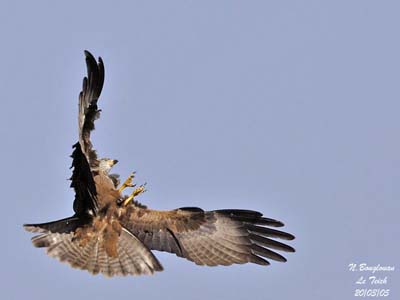
Milvus migrans
This type of flight displays is performed by numerous birds of prey such as eagles, hawks, buzzards, kites, falcons… from the largest to the smallest. Even the large Bearded Vulture – Gypaetus barbatus, performs these acrobatic aerial displays.
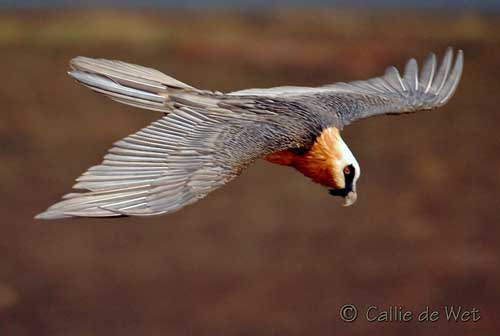
Gypaetus barbatus
However, some of the heaviest vultures perform more simple flights, both mates circling, soaring and gliding together. They can fly one above the other for long time, and this flight is named “Fly in tandem”. This is the case of the large Old World vultures of the genus “gyps”.
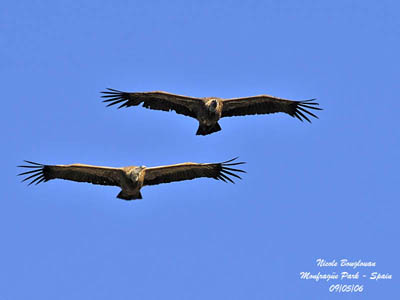
Gyps fulvus
Outside raptors, other birds’ species perform flight displays often accompanied by calls. During these flights, the birds rise vertically or spirally in the air before to dive from some height while singing. We can also observe chases with the male pursuing the female, and some “dances”, or flapping-flight producing well audible noises, followed by glides on closed wings.
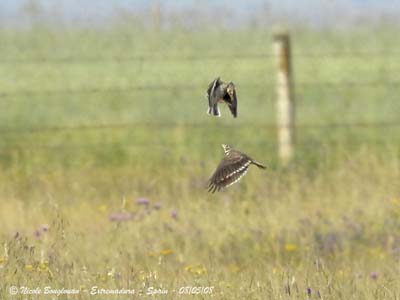
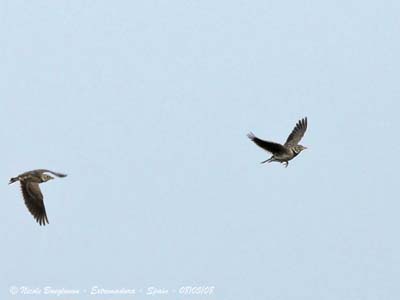
On the other hand, the males of several species from large to very small, display at “leks”, an area which provides them all the necessary places for strutting such as low branches, mounts or rocks, where the males can sing and display. They display either alone in a small territory within the lek, or in groups with a hierarchy giving the right place to each bird.
The females look at them from the boundaries or even within the lek, observing attentively each male in order to choose the strongest and the most beautiful of them.
These types of displays occur in large birds such as bustards and grouses, or in small species such as manakins and hummingbirds.
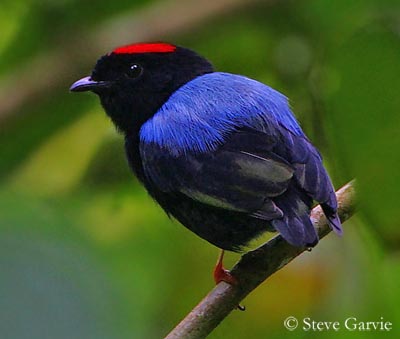
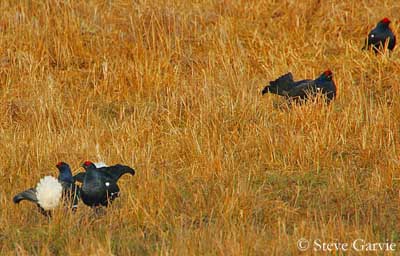
The aquatic species, and especially waterfowls, usually display in the water, using different postures to expose the brightest areas of their body. Several males pursue one female and mount her as ducks’ species often do. Copulation occurs in the water.
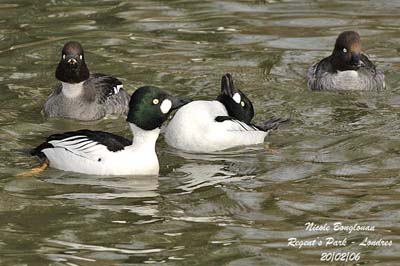
Bucephala clangula
But courtship displays also involve some “gifts” from male to female. In several species, the male offers something to the female. Food is the most usual gift. The male gives her some prey such as insect, caterpillar, small mammal, fish, snake or other piece of food according to the species and its feeding behaviour.
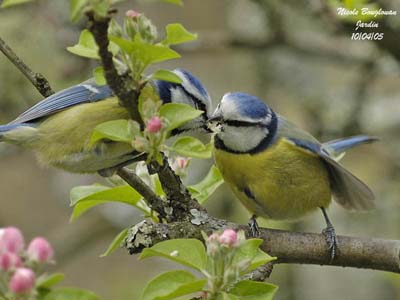
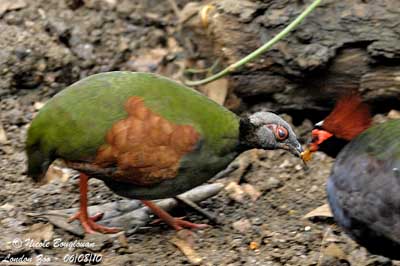
This food plays an important role before the laying. It has a nutritional importance when the female is forming the eggs.
Feeding by male may continue during the incubation. In numerous species where female incubates alone, the male often brings her preys at nest. Some variants are observed with male calling the female close to the nest or in the surroundings, or food transfer takes place in mid-air, as in Northern Harrier - Circus cyaneus. This type of courtship feeding often involves spectacular aerial movements.
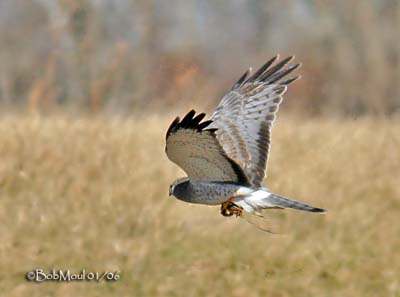
Circus cyaneus
However, males may also offer different kind of gifts, as a petal of flower, which is more frequent in species such as birds of genus “Malurus” such as the Superb Fairywren – Malurus cyaneus, or twig, rootlet, grass, all kind of materials used to build the nest.
The Great-crested Grebes – Podiceps cristatus, perform mutual offering of vegetation after an elaborated dance during which male and female are facing each other and move alternatively head and neck.
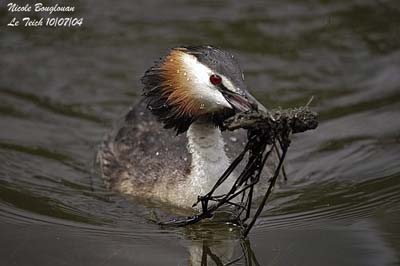
Podiceps cristatus
The White Storks – Ciconia ciconia, use materials, involving greeting-displays at nest when the male brings some grasses or leaves.
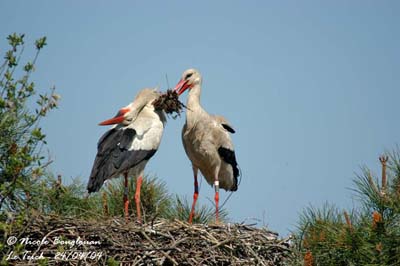
Ciconia ciconia
Several Ardeidae species display at nest with a stick in the bill, whereas egrets expose and shake their beautiful long nuptial feathers in undulating manner while perched on branches in trees. These birds show bright coloured lores, bill and legs during the breeding season.
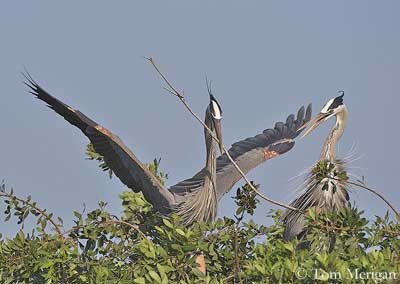
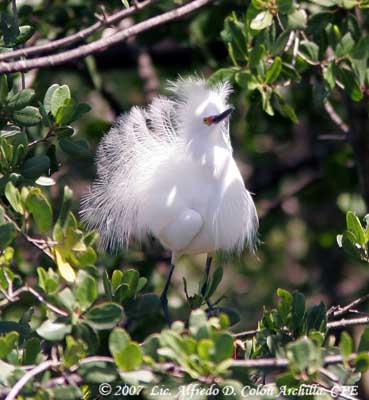
The main goal of the gifts is to prove to the female that a male is able to find materials to build a strong nest and numerous preys to feed the young.
Other spectacular behaviours are observed in Bowerbirds. Some males such as the Satin Bowerbird - Ptilonorhynchus violaceus, and the Great Bowerbird - Chlamydera nuchalis (but others do it too), build a “bower”, a kind of terrestrial structure made with two rows of sticks and stems forming an arch or even with a roof, but also with ornaments such as feathers, flowers, leaves, stones, berries, shells, plastic items, pieces of glass… These items are different according to the bird, and often closely associated to him. The Satin Bowerbird uses only blue items, as its plumage! The bower and these objects show the ability of the male to find nest-materials from the habitat and are used to attract females which visit several places and watch the displaying males, in order to select the best one. After mating, the nest where the eggs will be laid is built by the female. She rears the young alone while the male try to attract other females.
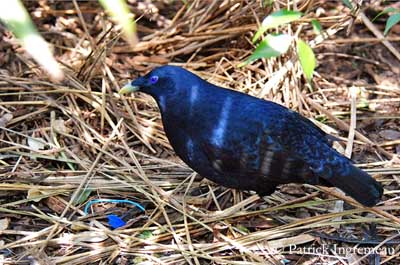
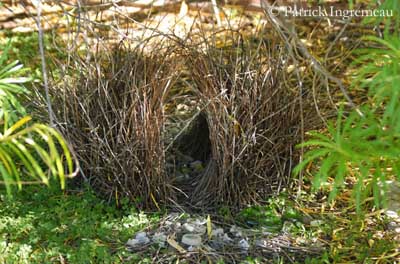
The Birds-of-paradise have elaborated and spectacular displays, performing mating dance in front of the female, in order to expose their superb plumage. They ruffle their feathers and fan tail and/or wings, producing some vibrations which enhance the bright coloured feathers and the beautiful plumage pattern. During these displays the male often hangs upside down on a branch or perches on shrub or bush. It calls loudly while displaying alone or in groups at lek.
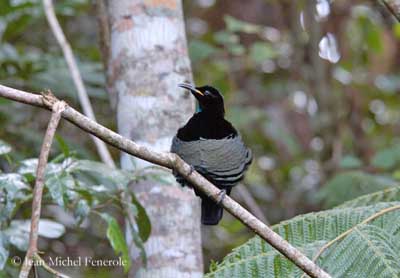
Victoria's Riflebird
Ptiloris victoriae
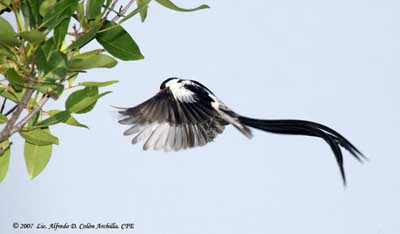
Vidua macroura
This type of display is also observed in the Scissor-tailed Nightjar - Hydropsalis torquata, but this one struts mainly on the ground where the different movements are accompanied by the long tail.
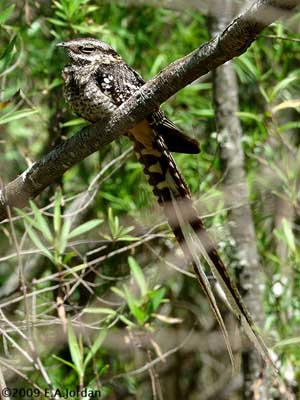
Hydropsalis torquata
Some birds showing a bright coloured gular pouch such as the Magnificent Frigatebird - Fregata magnificens, inflate this pouch during the displays and strut in front of the female. However, the gular pouch of Pelicans is only used for fishing!
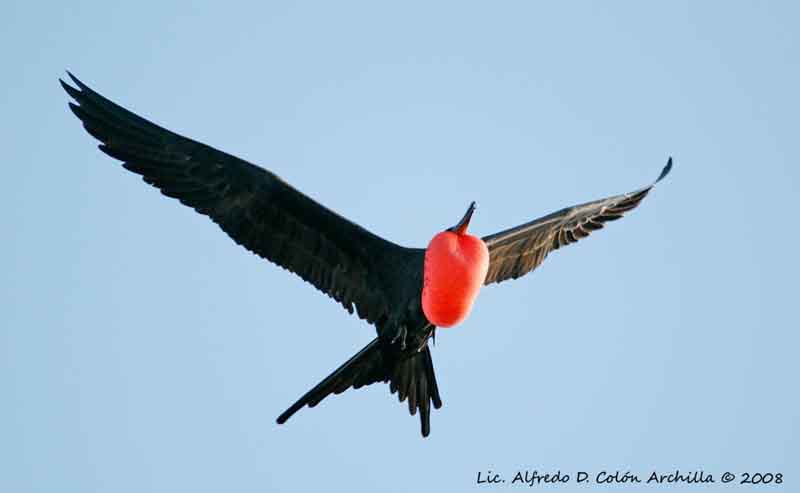
Fregata magnificens
Seabirds and shorebirds perform aerial displays and courtship feeding, often flying together above the colonies or the nest-site and sometimes with a fish in the female’s bill.
However, some birds such as the Wilson’s Phalarope - Phalaropus tricolor and other similar phalarope species have reversed behaviour. The female usually initiates the displays. She has brighter plumage and is larger than male. Her behaviour is that of males of other species, leaving the nest after laying while the male incubates and rears the young.
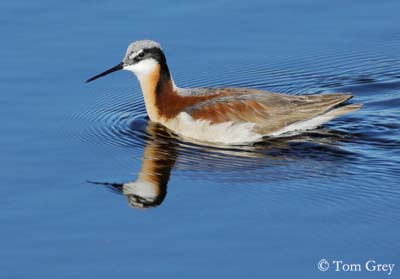
The mutual preening is a display shared by almost all the birds’ species and widespread as in large or small birds. They regularly preen their feathers in order to keep them healthy and clean for flying. But during the breeding season and after the pair is formed, they perform mutual preening. Each bird preens the feathers of its mate.
The Columbidae species such as pigeons and turtles are often observed preening the head and neck feathers of the mate.
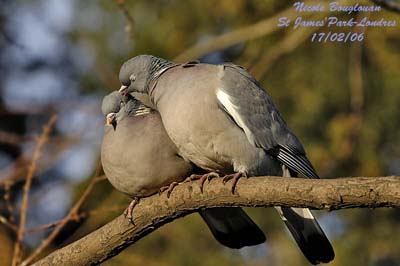
Columba palumbus
During the breeding season, males often fight with rivals, first to establish the boundaries of the territory, but also to prove their ability to defend the nest-site and the chicks. Females sometimes provoke these actions, in order to observe and select the strongest male, able to protect them and their brood.
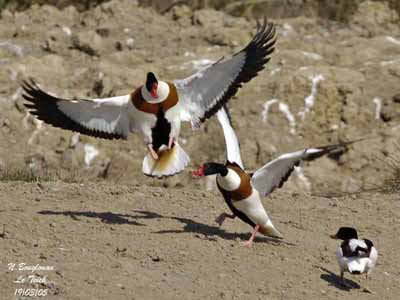
Tadorna tadorna
The main goal of all these courtship displays is to prove that a male is able to build a nest, to protect this nest and the territory against predators and rivals, to feed the incubating female and the chicks and to rear the young after fledging.
For that, the male use several postures and flights in order to appear larger than usual, with brighter colours, strong bill and claws to hunt and bring food at nest, able to utter melodious but loud songs and advertising calls becoming softer to communicate between mates and young.
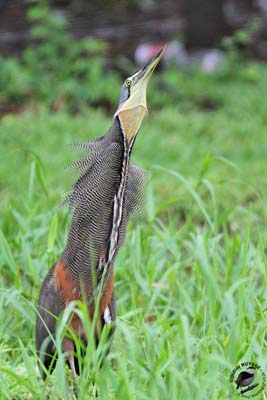
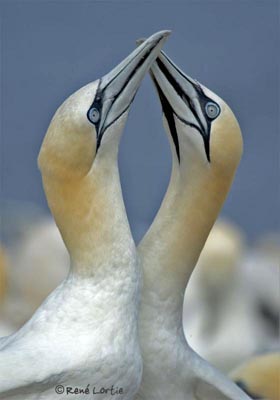
Bare-throated Tiger Heron
Tigrisoma mexicanum
Morus bassanus
These displays are also used in defence behaviour. Postures and movements are often the same, but their goal changes according to the situation. In front of a rival or a predator, the bird also exposes its bright colours, or spreads wings and tail to appear stronger and larger, displaying colourful patches enhanced by vibrations, jumps, flights, bows and many other movements on the ground, in trees or in the air.
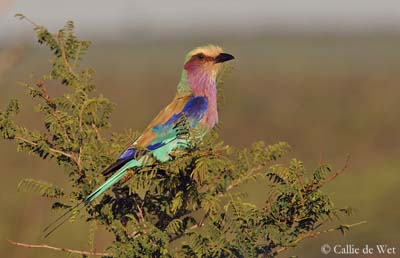
Coracias caudatus